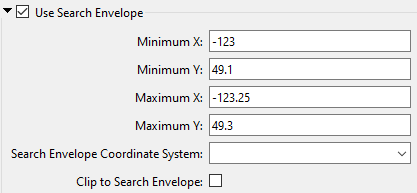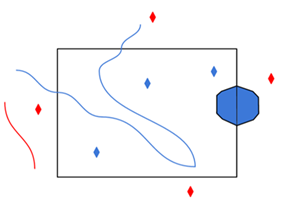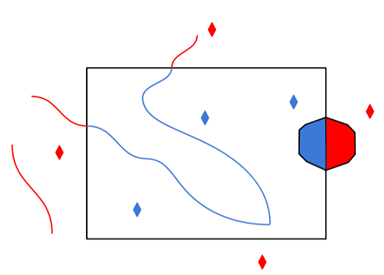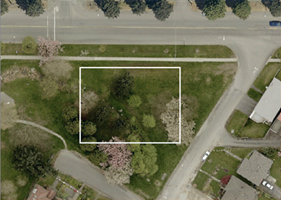Feature Assembly Mode
Switches E00 reader between "raw" and "normal" modes. Usually, the various bits and pieces of ArcInfo coverages (E00, binary, or PC binary) are combined to make wholly formed features, complete with attributes and resolved topology, but there are very rare special cases where it is useful to consider the pieces of the features as separate entities. This is mostly designed for performing ArcInfo-to-ArcInfo translations, where some simple manipulation of the feature's coordinates is being performed along the way.
Text Curves
Controls how the E00 reader works with text elements that follow a splined curve in ArcInfo. The options allow you to control the display of the curved text features.
- Follow (default) – Space the characters along the original curve, and generates a separate character for each (non-whitespace) character of the text.
- Fit – FME evenly spaces the characters of the text along the curve, so that the left edge of the first character is on the first point of the curve, and the right edge of the last character is on the last point.
- Ignore – The start and end points of the text line are used to compute the average rotation of the characters, and the first point in the line becomes the text's position. This is FME's traditional behavior, drawing a straight line from the first point of the curve to the last point, and placing the text along that line.
Optional Feature Types
ArcInfo coverages typically include an info file named BND, which defines the extents of the coverage.
FME usually ignores the contents of this file, but if this parameter is checked, FME will create a single feature representing the coverage extent information.
ArcInfo coverages typically include an info file named TIC, which defines the tic points for the coverage.
FME usually ignores the contents of this file, but if this parameter is checked, FME will create a feature for each TIC point.
Traditionally the ArcInfo reader reads the NAT table and outputs the NODE attributes as a plain set of attributes. If this box is checked, the endpoints of the ARC features are turned into NODE features, which are then joined with the NAT table attributes to provide fully formed point features.
File Contents
This parameter controls which character encoding is used to interpret text attributes from the file. Using this parameter along with the encoding value ensures that the original data is preserved from the reader to the writer.
By default, the character encoding will be automatically detected from the system (fme-source-encoding).
If you select any other character encoding, it will take precedence over the automatically detected character encoding.
FME supports most encodings.
Schema Attributes
Use this parameter to expose Format Attributes in FME Workbench when you create a workspace:
- In a dynamic scenario, it means these attributes can be passed to the output dataset at runtime.
- In a non-dynamic scenario, this parameter allows you to expose additional attributes on multiple feature types. Click the browse button to view the available format attributes (which are different for each format) for the reader.
Spatial
Coordinate systems may be extracted from input feature data sources, may come predefined with FME, or may be user-defined. FME allows different output and input coordinate systems, and performs the required coordinate conversions when necessary.
If a coordinate system is specified in both the source format and the workspace, the coordinate system in the workspace is used. The coordinate system specified in the source format is not used, and a warning is logged. If a source coordinate system is not specified in the workspace and the format or system does not store coordinate system information, then the coordinate system is not set for the features that are read.
If a destination coordinate system is set and the feature has been tagged with a coordinate system, then a coordinate system conversion is performed to put the feature into the destination system. This happens right before the feature enters into the writer.
If the destination coordinate system was not set, then the features are written out in their original coordinate system.
If a destination coordinate system is set, but the source coordinate system was not specified in the workspace or stored in the source format, then no conversion is performed. The features are simply tagged with the output system name before being written to the output dataset.
For systems that know their coordinate system, the Coordinate System field will display Read from Source and FME will read the coordinate system from the source dataset. For most other input sources, the field will display Unknown (which simply means that FME will use default values). In most cases, the default value is all you'll need to perform the translation.
You can always choose to override the defaults and choose a new coordinate system. Select More Coordinate Systems from the drop-down menu to open the Coordinate System Gallery.
Changing a Reprojection
To perform a reprojection, FME typically uses the CS-MAP reprojection engine, which includes definitions for thousands of coordinate systems, with a large variety of projections, datums, ellipsoids, and units. However, GIS applications have slightly different algorithms for reprojecting data between different coordinate systems. To ensure that the data FME writes matches exactly to your existing data, you can use the reprojection engine from a different application.
To change the reprojection engine, Select Workspace Parameters > Spatial > Reprojection Engine. In the example shown, you can select Esri (but the selection here depends on your installed applications):
- The coordinate systems file coordsys.db in the FME installation folder contains the names and descriptions of all predefined coordinate systems.
- Some users may wish to use coordinate systems that do not ship with FME, and in those cases, FME also supports custom coordinate systems.
- Learn more about Working with Coordinate Systems in FME.
A search envelope (also known as a bounding box) is a rectangular area that defines a geographic area. In FME, the easiest way to define a search envelope is to use search envelope parameters.
Defining a search envelope is the most efficient method of selecting an area of interest because FME will read only the data that is necessary – it does not have to read an entire dataset. Search Envelope parameters apply to both vector and raster datasets and can be particularly efficient if the source format has a spatial index.
Most FME readers have parameters to define the search envelope of data that is being read:

The parameters include the x and y coordinates of the bounding box as well as a parameter that defines the coordinate system.
How to Define the Bounding Box
Using the minimum and maximum x and y parameters, define a bounding box that will be used to filter the input features. Only features that intersect with the bounding box are returned. Note that the bounding box intersection is not a full geometry intersection (based on spatial relationships) that would be returned by a transformer like the SpatialFilter.
|
Search Envelope Coordinate System |
Specifies the coordinate system of the search envelope if it is different than the coordinate system of the data. The coordinate system associated with the data to be read must always be set if this parameter is set. If this parameter is set, the minimum and maximum points of the search envelope are reprojected from the Search Envelope Coordinate System to the reader’s coordinate system prior to applying the envelope. |
||||||
|
Clip to Search Envelope |
The underlying function for Use Search Envelope is an intersection; however, when Clip to Search Envelope is checked, a clipping operation is also performed.
|
Advanced
If the reader is placing the text characters along their curve (i.e., if Text Curve is not set to Fit or Follow), it usually inspects the text content to try detecting any multi-byte representations of “international” characters. If the reader finds a pair of bytes that seem to define a single character, it will use those 2 bytes in a single feature representing that character of text.
This behavior could lead to incorrect representation of some character strings, if they happen to be composed of single-byte characters that look like multi-byte characters. You can disable automatic detection of multi-byte characters by setting this parameter to Yes.




